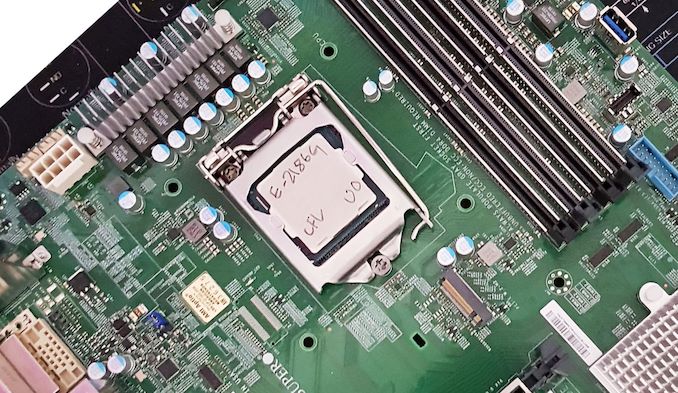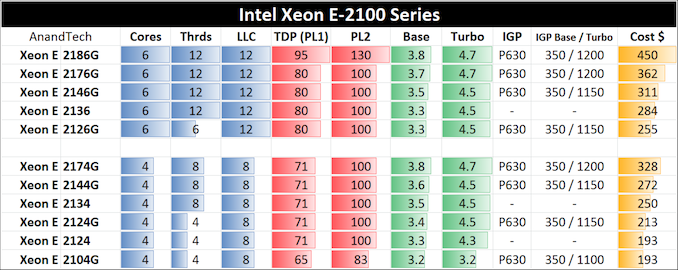Intel Xeon E Six-Core Review: E-2186G, E-2176G, E-2146G, and E-2136 Tested
by Ian Cutress on November 5, 2018 12:00 PM EST- Posted in
- CPUs
- Intel
- Xeon
- Enterprise CPUs
- Xeon E
Xeon E Six Core Conclusion
The Xeon E family is actually a niche element to Intel’s portfolio. For the datacenter, when costs are amortized at scale, is usually becomes beneficial to invest in the big iron Xeon-SP processors to take advantage of more performance, more PCIe lanes, additional connectivity, and the support that OEMs provide. Xeon E ultimately ends up in commercial systems where some form of grunt is needed, but also where ECC is needed or an IT department is looking for strict control in a company-wide deployment. That said, there are a number of home users who may wish to invest in this platform for their personal setups.
Intel’s game here is features for money: the Xeon E parts do ECC and advanced management, some parts come with graphics, and this will tack on a few more dollars on to a system build. The only question is which processor to get, and how much will it cost.
The Xeon E family is currently split into six-core processors and four-core processors, varying mostly in frequency rather than power, with a couple of low-end processors without hyperthreading. All of the E-2100 parts come from Intel’s Coffee Lake microarchitecture, similar to Intel's 8th Gen Core processors, and in fact we’re pretty sure it’s the same silicon die with a few features in silicon enabled/disabled (as is usually the case). In this review, we tested most of the six-core offerings that should be available in the next few weeks.
Even on paper, there is not much to separate all the six-core offerings. The E-2126G starts at $255 tray price, with six cores and no hyperthreading, and it goes up to the E-2186G at $450 tray price with six cores, hyperthreading, and some more base frequency and turbo frequency. With all of the six core processors here varying from 3.3 GHz to 3.8 GHz base frequency and 4.5 GHz to 4.7 GHz turbo frequency, they should perform roughly the same.
And indeed in our testing this is what we find. I mean, these parts are so eerily similar to each other, the results form a super tight grouping, with run-to-run variation deciding which processor is going to take the top spot. The extra TDP of the E-2186G at 95W, rather than the 80W of the other processors, doesn’t mean much as these processors always go into a TDP limited mode.
In this case, the recommendation is simple: get the E-2136 if integrated graphics isn’t needed, and the E-2146G if they are needed. These two Xeon E processors both hit the price/performance ratio by having the same practical performance as the top end E-2186G, but end up costing 33%+ less.
There is no real reason to recommend the E-2186G, unless you want to say you have the top Xeon E – and who really is going to boast about that?
Upgrading from Xeon E3-1200 v5
For this review, we were able to rustle up two of the top Xeon E3-1200 v5 parts for comparison. Back in the day, the E3-1280 v5 was the top end processor and was offered at a cool list price of $612, or the smarter option was the E3-1270 v5 for over $200 less for 100-200 MHz lower frequencies.
For users on the older v5 parts, an upgrade to the Xeon E family would mean a complete system refit: motherboard, CPU, and memory. This means that the upgrade cycle would need to offer a good deal of performance in order to be worthwhile. If we compare the E3-1275 v5 (without graphics) to our recommended E-2136, then the performance uplift is substantial.

With the E-2136, there are two additional cores to play with, as well as a much higher turbo frequency (the list price is also lower, for what it is worth, potentially lowering the Capex from the v5 upgrade). In our benchmarks, some of the quick tests saw a 10-20% speedup, while the larger throughput tests saw a 50-75% speedup, such as our compile test that saw the ability to process 70% more data in the same tie. Encoding was up 53%, rendering up 68%, emulation up 19%.
The only downside is that even though both processors are listed at 80W TDP, we measured the E3-1270 v5 at 63W peak power consumption, and the E3-2136 at 95W peak power. It’s a calculation to make: higher power costs for faster workflows.
For users that don’t need ECC, options will stem from the consumer line of processors. The Core i7-8700 family of processors also have six cores and twelve threads, but push the base frequency up higher, which also increases the power, and the price. However there are a larger number of motherboards to choose from, which maybe cheaper.
Unfortunately AMD hasn’t engaged us in testing their Ryzen Pro processor line, despite my requests, so it’s hard to get a read here on how they might fare based on the target markets. The six-core, twelve-thread Ryzen 5 2600X is the consumer version of the Ryzen 5 Pro 2600X, and costs $50 cheaper than the E-2136. The battle between the benchmarks can be close at times, however Intel tends to win most of the time by up to 10%. That might not be worth the $50, but it would be interesting to see these two processors in a head-to-head review.
Six Core Xeon E: Almost Identical Parts, So Buy The Cheap One
I’ve wanted to get to grips with the Xeon E/Xeon E3 family for a while. We managed to get in a set of v4/v5 processors a while back, but close to the v6 launch. Unfortunately Intel never sampled the v6. This time around we took the initiative for alternative sourcing, and the goods look good – in fact when you pair all the six-core parts together, it’s a bowl of identical fruit with different price stickers.
Intel’s strategy is a little odd here, announcing the Xeon E parts in July but then having a review embargo in November. While there have been parts listed at retailers, none have actually ever been in stock, with no ETAs. Technically today is a ‘secondary announcement’ around server deployment for Xeon E, although given the lack of retail availability, this is probably more like the ‘real’ launch than the July announcement was.
With the launch being today, there is perhaps a question if this has anything to do with Intel’s recent increase in demand for its server platform, which puts pressure on Intel’s manufacturing resources, to be unable to make enough Xeon E parts. Xeon E is a small part of the Xeon business after all. That being said, Intel still has strong demand for the Xeon-SP parts, which doesn’t look like it is subsiding with reports that it might be unable to fill sales orders. As a result, I wonder what bar has been reached in the manufacturing process that has enabled a sufficient quantity (whatever that means) of Xeon E to be made available.
There’s actually a funny story here: after hearing nothing from Intel about Xeon E since July, without prompting, two users in the last week emailed me about the availability of Xeon E. Sorry to the both of you, I couldn’t say anything due to NDAs. But kudos on timing! I hope they hit retail soon for the readers that are interested in getting their hands on them. In the meantime, I’ll try and rustle up some v6 parts for a generational comparison.











48 Comments
View All Comments
unsleepable - Thursday, November 8, 2018 - link
Any word on the lower-power members of the family? I imagine Intel will still release equivalents to previous generation processors like the Xeon E3-1260L v5, or counterparts to the i7 T CPUs like the Core i7-8700T, right?Chaitan - Saturday, November 10, 2018 - link
There is an interesting statement for these CPUs on ark: "Support for up to 128GB system memory capacity will be available in 2019 through a published BIOS Update. Please contact your hardware provider for availability and support."Does it mean that these will be the first mainstream CPUs with officially provided microcode for Intel memory controller to support 128GB?
Laptops with 128GB RAM support were announced several months ago by Dell, Lenovo and MSI (the latter with desktop CPUs and C246 chipset), but so far CPUs and BIOS for these laptops require custom OEM-specific CPU microcode for memory controller to really support such capacity.
Madao - Saturday, November 10, 2018 - link
I got lucky; got a 2176G on my doorstep from Provantage like Oct 20 for $330. X11SCA-W was in stock on newegg at the same time. I wanted the cheaper ASUS board but it was in stock nowhere.Really pisses me off that AMD and mobo makers dropped the ball on ECC. It should be standard in all computers and even phones. It only needs a few extra ram traces ffs --;
rannyjohns - Thursday, November 15, 2018 - link
I love your blog. And I always find something new here that I either hadn’t seen before or somehow managed to pass over. Thank you for this post! I am recently hoping to reach out and build my network in order to have more of a true collaboration going on, try more solution withasgehrj - Friday, December 14, 2018 - link
I'm not sure I agree that the only reason to get the top model is bragging rights.Agreed, turbo speed is very close to the lower end models, but:
It can sustain a 15% faster base clock than the lower end models, which is meaningful in e.g. render time. (It would almost equal an imaginary 7 core 2136)
"So buy a cpu with more cores" I hear you say...
True in most cases, but I'm building a 3D workstation, where the CAD application likes high single core clock speed , which is hard to find in the models with even more cores. The same machine also does the rendering, so in this case I'm pretty sure the 2186G (or the ..76G) is the better choice.